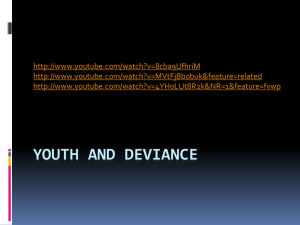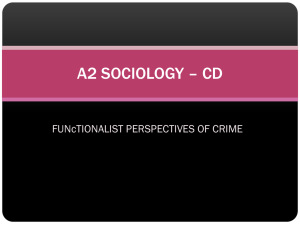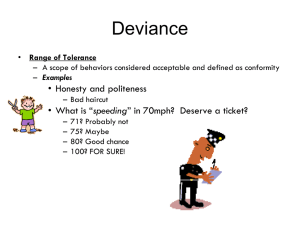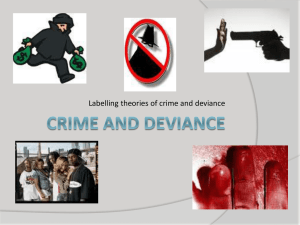The Social Construction of Crime (PPT)
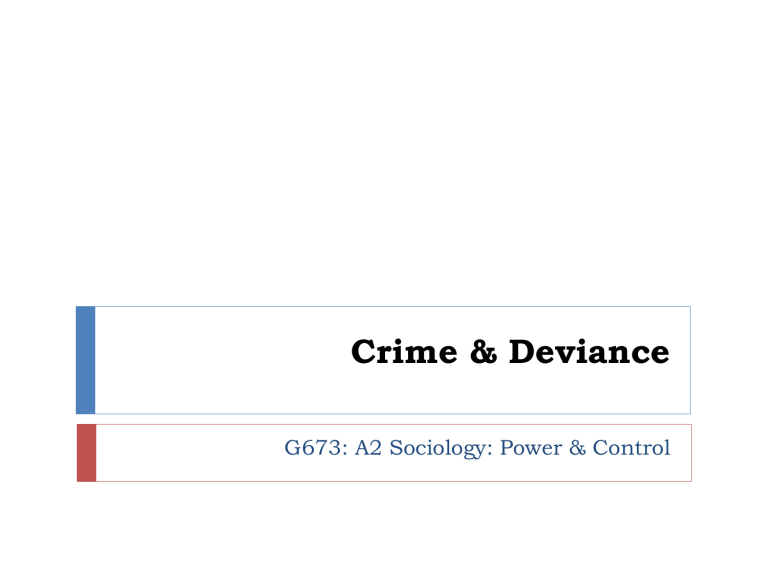
Crime & Deviance
G673: A2 Sociology: Power & Control
Learning Objectives
Compare differences between A2 and AS expectations
Define the concepts: Crime, Deviance and
Delinquency.
1.
Outline and evaluate the view that crime and deviance are socially constructed by:
Identifying different interpretations of crime/deviance
2.
3.
Providing examples of how crime and deviance are culturally and historically relative
Summarising the biological construction argument
A2 vs. AS
G673
Exam answers are unstructured
There is a choice of questions (for G673, you choose 2 out of 3 possible questions).
Synoptic Links are encouraged
Evaluation and Analysis are even more vital – and can be the difference between success and failure.
Overall, you are expected to write in depth and demonstrate a detailed understanding of theories and concepts.
How you are marked:
Assessment Objective (AO)...
AO1. Knowledge and Understanding
(use of studies, theories, concepts and examples)
AO2. Interpretation and Application
(how well you interpret knowledge and apply it to the question asked)
AO3. Evaluation and Analysis
(judgements, criticisms, appraisals and assessments of knowledge)
How to Meet it...
• _______ argued...
• A study by _______ explored...
• A useful example is __________....
• The concept of ______....
• This means...
• Therefore...
• This shows...
• In relation to...
• However...
• This was criticised by ________...
• On the other hand...
• A different view is offered by ______...
Unit Content
The Social Construction of Crime/Deviance
Sociological perspectives on crime and deviance
Patterns of Crime by: Gender, Age, Ethnicity, Class,
Geographical Location
Victimology
Solutions to the Crime Problem
Discuss
Who here has broken the law?
Disclose your crimes to the class.
Initial Task: Discuss (Pairs/small groups)
What was the real reason for the UK riots in August
2011? Are some individuals just born bad, or were underlying social problems to blame?
Present a balanced argument...
Individually - DEFINE
Crime
Deviance
Delinquency
Ext: - Provide at least two examples for each...
Clinard & Meier (2001): Ways of Defining of Deviance.
Statistical – Deviance is behaviour that is different from the
‘average’ (e.g. What most people do is ‘normal’)
Absolutist – Deviance is behaviour that contradicts the agreed values of a society
Reactivist – Deviance is a label applied to some acts and some people; labels are only applied when society demands them, so deviance only exists when there is a societal reaction.
Normative – Deviance is behaviour which contradicts social norms.
Different Forms of Deviance
Societal – most people agree the behaviour is deviant
(e.g. armed robbery)
Situational – the behaviour is deviant in the context of a certain social situation (e.g. using mobile phone in class)
+ Your own examples
Forms of Deviance
Concealed - hidden away from public view (e.g. a serial killer)
Public/Collective - deviance is a collective experience, conforming to norms of outsider group (e.g. New Age
Travellers).
+ Your own examples
Definitions of Crime
“Any activity that breaches the law of the society in which it takes place...”
Discuss:
What activities are considered deviant but not criminal?
Are there any ‘crimes’ which are not deviant (e.g.
Are seen as normal?)
Definitions of Crime
In theory, all crime should be deviant, as the laws of a society should reflect its norms and values...
...However, there may be exceptions. For example, it could be argued that speeding is a norm (therefore it is criminal, but not deviant).
Discuss
If you found cash on the street, at what point would you feel it necessary to hand it in to the police? 5p? £5? £50? £500? Would you hand it in at all? Would it make any difference if it was in a wallet or a purse?
Hagan (1994) – Factors that affect the way crime & deviance are perceived
Social Agreement – if the public are divided on how much a law benefits society, it may be weakly enforced (e.g. Animal rights law)
Social Response – The way in which people respond to a crime will affect the severity of its sanctions (e.g. Drug use)
Social Harm – The severity of an act is often determined by how much ‘harm’ it is perceived to have caused.
‘Victimless’ crimes may be weakly enforced...
Discuss (Small Groups)
What do you think are the five most serious crimes and why? (Rank in order)
How does your list fit in with Hagan’s three factors
E.g. : Does enforcing these crimes benefit society?
Is public reaction against these crimes strong?
Do the crimes cause obvious harm to people?
Defining Crime & Deviance
In groups, study the following images.
Decide which ones are acts of crime and/or deviance and why.
Do you think society as a whole would agree with you?
To what extent does it depend on where, why and
when each act was committed in deciding whether or not it is criminal/deviant?
Crime & Deviance
So, deviance has so many definitions, types and interpretations…
…and there are many factors impact our view of what crime is and perceptions of how/when crime is serious.
This supports the view that crime and deviance are socially constructed: Because we can apply so many different interpretations/meanings.
Crime & Deviance
Crime and deviance can be viewed as culturally and historically relative.
Whether an act is judged criminal or deviant depends on the country in which it takes place and the point in time in which it occurs.
In Pairs...
Provide three examples of things that are:
Legal in the UK, but used to be illegal.
Illegal in the UK, but used to be legal.
Illegal in the UK, but legal elsewhere.
Legal in the UK, but illegal elsewhere.
Ext: - Three things that are considered illegal and/or immoral in almost every society.
5 mins: Then feedback...
T.A.R.D.I.S
What do the initials stand for?
We say that Crime is relative to time and space
This suggests that crime is therefore socially
constructed.
The Social Construction of Deviance
To be socially constructed is to be created or interpreted as a result of the culture and/or structure of your society.
Crime & Deviance are social constructs. Something is not deviant until society defines it to be so. And what a society defines as deviant will be based on its own particular culture, values etc.
Which is why what is considered deviant is different in different societies and cultures and at different times.
Activity (Pairs)
Explain how the following may vary over time and space:
Drinking alcohol
Being an unmarried mother
Homosexuality
Nudity
Body piercing
Speaking in Tongues
5 mins: Then feedback
Social Construction: Why?
If something is not socially constructed, it may be biologically constructed.
If crime is biologically constructed, it must be ‘built in’: We would all be born knowing what is right and wrong, or ‘good’ and ‘evil’.
If this was the case, why would different societies – and at different times – disagree about what is right and wrong?
The social construction argument says that crime is relative
and subjective; different societies develop their own social
norms and values and this is where our ideas about right and wrong develop...
However...
There are issues with the social construction argument, because there are some things that nearly everyone recognises as wrong, regardless as norms and values.
For example, surely the treatment of the Jews by the Nazis is not relative and subjective...
The Biological Argument: Who is Criminal?
Cesare Lombroso (1835-1909)
Cesare Lombroso claimed to be able to use biological features to identify criminals.
His work is now discredited – but still recognised as an important contribution to criminology, as it was the first attempt to apply scientific principles to the study of crime.
Biological Evidence...?
There is some more concrete evidence for the biological construction argument e.g....
Brain/hormonal differences of psychopaths
Studies supporting that female crime is exacerbated by
PMT!
However, sociologists generally dispute or ignore the wider argument...
Social Constructionism: Case Study
Smoking (Troyer & Markle; 1983)
1800s: Smoking condemned; linked to other
‘undesirable’ activities e.g. prostitution, immigration...
Post-WW1: Smoking desirable (possibly due to smoking among soldiers)...becomes symbolic of style and status for some...
1960s +: Smoking increasingly condemned as science makes links to deadly illnesses...
As norms change, legislation changes with them – and thus so does deviance
Further Evaluation of the S.C. argument
Some claim that the social constructionist argument makes us ignore the crime problem.
It implies we can eradicate crime and deviance just by changing the definitions:
But does this make for a better society?
Exam Advice
It is likely that you will get a question on the social construction of crime/deviance.
You need to be able to describe why and how sociologists believe crime is socially constructed (and briefly identity flaws in this view and/or alternative views).
You also need to be able to describe the roles of the
mass media and the criminal justice system (inc. police, courts etc) in the social construction of crime. We will deal with these aspects later in the unit.
Discuss
“The Popular Garden Annual (1929) advises that, to obtain a graceful decorative border, a few plants of the Hemp (Cannabis) might be included, for the sake of the tall, leafy stems”
How does this quotation illustrate the idea that crime and deviance are historically and culturally relative?
Homework
Criminals are not born, they are made.
Write 1000 words (blog/written submission) evaluating this statement.
Due: TTNW
Perspectives Recap/Research:
In pairs, note down everything you can recall of your learning so far regarding (You may need to consult moodle!):
FUNCTIONALISM
MARXISM
FEMINISM
POSTMODERNISM
INTERACTIONISM
Ext: - Based on the above, what would you predict each might say regarding Crime & Deviance
(10 mins: Then Feedback)

